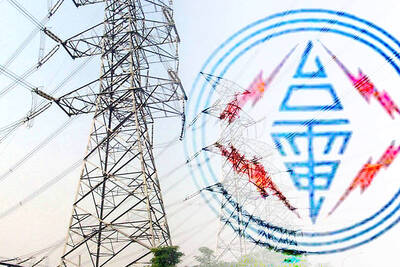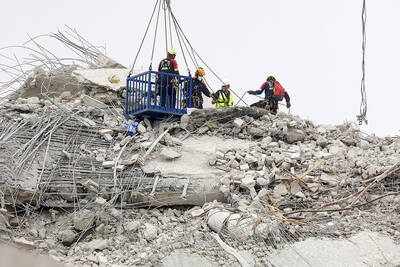Persian Heaven, which opened five years ago, stands out on Taipei’s dining scene as one of the few places to sample Persian cuisine. Founded by an Iranian businessman, the dining lounge on Nanjing East Road (南京東路) features regular belly dance performances. Subdued lighting, loud music and cabinets filled with knick-knacks like busts of ancient Persian kings add to the fun and slightly kitschy atmosphere.
For an extra NT$150, most entrees are available as set meals, which are a bargain if you want to get a sampling of Persian Heaven’s expansive menu. Each set comes with a full-sized salad, soup, appetizer, side dish, dessert and drink, in addition to the main course.
We paired ghorme sabzi, or stewed beef cooked with split peas and vegetables (NT$370), with an order of Iranian bread (NT$60). Made from white flour, the bread was thin and chewy, like a tortilla, and not particularly memorable. The beef in the ghorme sabzi was juicy and the dish would have gone better with Persian Heaven’s saffron polo (NT$80), or white rice flavored with fragrant saffron.
The upbeat-sounding triple happy kebab king (NT$530) features a skewer each of beef, lamb and chicken and is probably the most attractive dish on the menu, with the gleaming chunks of meat set off by a colorful assortment of vegetables. The meat was succulent but had little seasoning, so we made sure to douse each skewer in limejuice to set off the flavor. On a separate visit, I ordered the meat and seafood combo kebab (NT$550), which came with two meaty, perfectly grilled tiger prawns, along with lamb (beef is another option).
Most of Persian Heaven’s salads use potato as the main ingredient, including the delicious chilled salad Olivier (NT$100), in which the tuber is diced and mixed with celery and chicken. There are only two appetizers. The seafood plate (NT$100) is a patty of chilled mashed potatoes served with a steamed prawn and garnished with relish and dill. It was OK, but the heaven chicken roll (NT$100), a light crepe stuffed with chicken and garnished
with a savory cream sauce, is much better.
Persian Heaven’s soups are passable, but if you aren’t ordering a set meal, I suggest skipping them to save room for dessert. Made from semolina and butter and flavored with honey and saffron, the hal wa (NT$80) was surprisingly delicate instead of overpoweringly sweet. The texture was like a thick pudding, making the treat a great comfort food. It tasted especially good with a glass of tart lemonade, which came with the set meal. Another good bet is the thick, creamy rice pudding (NT$80). It was complemented by a glass of cinnamon-y iced Iranian tea (NT$120, also available hot).
Our servers were uniformly polite and helpful on both visits, but we waited half an hour for our main entree (the triple happy kebab king) on a busy Sunday night — enough time, in fact, to watch the cheerful belly dancer teach two diners how to roll their hips. Dinner on a weekday moved at a quicker pace — each course was served as soon as I had finished the previous one.

March 31 to April 6 On May 13, 1950, National Taiwan University Hospital otolaryngologist Su You-peng (蘇友鵬) was summoned to the director’s office. He thought someone had complained about him practicing the violin at night, but when he entered the room, he knew something was terribly wrong. He saw several burly men who appeared to be government secret agents, and three other resident doctors: internist Hsu Chiang (許強), dermatologist Hu Pao-chen (胡寶珍) and ophthalmologist Hu Hsin-lin (胡鑫麟). They were handcuffed, herded onto two jeeps and taken to the Secrecy Bureau (保密局) for questioning. Su was still in his doctor’s robes at

Last week the Democratic Progressive Party (DPP) said that the budget cuts voted for by the China-aligned parties in the legislature, are intended to force the DPP to hike electricity rates. The public would then blame it for the rate hike. It’s fairly clear that the first part of that is correct. Slashing the budget of state-run Taiwan Power Co (Taipower, 台電) is a move intended to cause discontent with the DPP when electricity rates go up. Taipower’s debt, NT$422.9 billion (US$12.78 billion), is one of the numerous permanent crises created by the nation’s construction-industrial state and the developmentalist mentality it

A vaccine to fight dementia? It turns out there may already be one — shots that prevent painful shingles also appear to protect aging brains. A new study found shingles vaccination cut older adults’ risk of developing dementia over the next seven years by 20 percent. The research, published Wednesday in the journal Nature, is part of growing understanding about how many factors influence brain health as we age — and what we can do about it. “It’s a very robust finding,” said lead researcher Pascal Geldsetzer of Stanford University. And “women seem to benefit more,” important as they’re at higher risk of

Experts say that the devastating earthquake in Myanmar on Friday was likely the strongest to hit the country in decades, with disaster modeling suggesting thousands could be dead. Automatic assessments from the US Geological Survey (USGS) said the shallow 7.7-magnitude quake northwest of the central Myanmar city of Sagaing triggered a red alert for shaking-related fatalities and economic losses. “High casualties and extensive damage are probable and the disaster is likely widespread,” it said, locating the epicentre near the central Myanmar city of Mandalay, home to more than a million people. Myanmar’s ruling junta said on Saturday morning that the number killed had